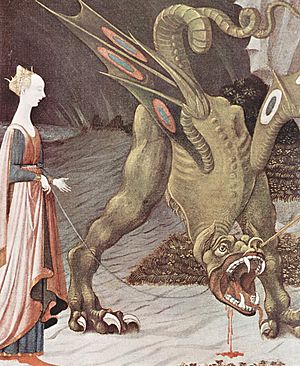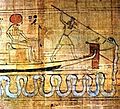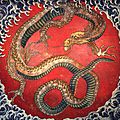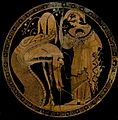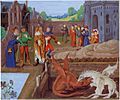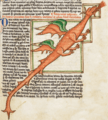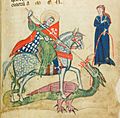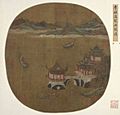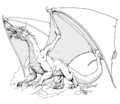Dragon facts for kids
The dragon is a legendary creature belonging to the world of mythology, storytelling, and fantasy. There are stories about dragons in Chinese culture, European culture, South American culture, and many others.
Dragons can look like dinosaurs and other extinct animals. Because of that, it is easy to think that those animals might have been an example for dragons as they were thought of in the history of humankind.
There are many kinds of dragons in different cultures. Usually, people think of dragons in these ways:
- A dragon has zero to four legs, claws, scales, and possibly spikes. They sometimes have wings.
- A dragon can look like a snake with wings or like lizards.
- A dragon has a tail and a long neck.
- A dragon has a wide mouth with big and dangerous teeth.
- A dragon sometimes has horns and hair.
- A dragon can fly.
- A dragon can breathe fire (or other dangerous substances).
- A dragon has special powers.
- Some dragons live in caves.
In stories such as The Hobbit or Beowulf, dragons are dangerous and attack humans. Other stories, such as those by Anne McCaffrey, have dragons who are looking for help or giving help. A dragon also appears in the Book of Revelation chapters 12-13, where he is seen as the Devil.
Interesting facts about dragons
- In China, dragons symbolize wealth, power, and leadership.
- Chinese emperors were believed to be descendants of dragons.
- A little dragon is called a "dragonet."
- In mythology, a female dragon is called a drakaina, which is the female form of the ancient Greek word for dragon, drakon.
- In the Harry Potter world, a wizard or witch who trades and sells dragon eggs is called a dragon dealer. It is illegal to trade and sell dragon eggs.
- Some Viking longships had carvings of dragon heads on their prows (fronts). The Vikings called these ships "drakkar," or "dragon ships."
- Red-colored stones are sometimes called "dragon stones" because they were believed to be hardened lumps of dragon blood.
- The Uroboros, or tail-biting dragon, symbolizes the eternal circle of life. It is also an important symbol for medieval alchemists.
- People who study dragons are called dragonologists.
Images for kids
-
An early appearance of the Old English word dracan in Beowulf
-
Several bones said to belong to the Wawel Dragon hang outside of Wawel Cathedral, but they actually belong to a Pleistocene mammal.
-
The Welsh Dragon is a heraldic symbol that represents Wales and appears on the national flag of Wales.
-
Hongwu Emperor with dragon emblem on his chest. c. 1377
-
Head of a dragon from a Chinese dragon dance performed in Helsinki in the year 2000
-
The Blue Dragon mural depiction at the Goguryeo tombs
-
Painting of a Japanese dragon by Hokusai (c. 1730 – 1849)
-
The mušḫuššu is a serpentine, draconic monster from ancient Mesopotamian mythology with the body and neck of a snake, the forelegs of a lion, and the hind-legs of a bird. Here it is shown as it appears in the Ishtar Gate from the city of Babylon.
-
The Destruction of Leviathan (1865) by Gustave Doré
-
Head of the dragon-god Pakhangba depicted on a musical instrument from Manipur, India
-
Ancient Greek mosaic from Caulonia, Italy, depicting a cetus or sea-dragon
-
Fifteenth-century manuscript illustration of the battle of the Red and White Dragons from Geoffrey of Monmouth's History of the Kings of Britain
-
Manuscript illustration from Verona of Saint George slaying the dragon, dating to c. 1270
-
Illustration of the Wawel Dragon from Sebastian Münster's Cosmographie Universalis (1544)
-
Modern fan illustration by David Demaret of the dragon Smaug from J. R. R. Tolkien's 1937 high fantasy novel The Hobbit
-
Tang dynasty painting of a dragon boat race attributed to Li Zhaodao
-
Members of the Chinese Youth Society of Melbourne performing for Chinese New Year, at Crown Casino, demonstrate a basic "corkscrew" routine
-
John Tenniel's illustration of the Jabberwock for Lewis Carroll's Through the Looking-Glass, showing the dragon as a myopic professor
-
Fire-breathing statue of the Ukrainian Ironbelly from Harry Potter and the Deathly Hallows – Part 2 at Universal Studios Florida
-
Representation of a dragon as it appears in the role-playing game Dungeons & Dragons
See also
 In Spanish: Dragón para niños
In Spanish: Dragón para niños


